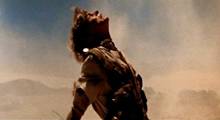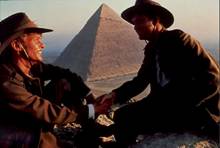1. Apocalypse Now (1979) with Martin Sheen, Robert Duvall, Frederic Forrest, Sam Bottoms, Larry Fishburne, Harrison Ford, G.D. Spradlin, Dennis Hopper, and Marlon Brando: Capt. Willard (Sheen) is given a mission, which “does not exist,” to “terminate” the command of Col. Kurtz (Brando) who ‘has clearly gone insane.”
This Francis Ford Coppola masterpiece captures the complete insanity of the Vietnam War. However, my conversations with Vietnam veterans have uncovered three “mistakes”: (1) Martin Sheen’s band aid would never had stayed on his cheek as long as it did; (2) The airborne units did not play Wagner’s “Ride of the Walkyries” during assaults on villages – they played other music selections instead; and (3) If you were in Vietnam long enough, you would have seen everything that is in this movie, but not on a single mission. Sheen’s patrol boat venture up river into Cambodia was described to me as being like driving down a road and hitting one pothole after another. I have been assured it wasn’t like that.
There are some legendary utterances in this film like Duvall’s “I love the smell of napalm in the morning” and Brando’s “The HORROR!”
2. Gallipoli (1981) with Mark Lee and Mel Gibson: This superb film by director Peter Weir depicts the senseless loss of life
resulting from the trench warfare of World War I. Gallipoli was
the Turkish stronghold that guarded the Dardanelles, and the
British wasted thousands of young lives trying to take it.
The story pivots around the relationship between two young
Aussies who meet when one (Mark Lee) defeats the other (Mel Gibson) in a foot race. Lee is eager to join the Light Horse Cavalry and go fight the Turks – Gibson decides to tag along.
Some years ago, on vacation in Ecuador, I met three other travelers, and we ended up traveling down the coast together. One girl was from Germany and two other girls were from Australia. Before we parted company in Bahia, I learned that one of the Australians was a movie buff, so I asked her to name Mel Gibson’s best film. Gibson was the biggest name from Australia at the time, so I presumed she kept up with his films. After only a moment of hesitation, she said, “Gallipoli.” I agreed, but I told her that I thought she might have picked The Year of Living Dangerously instead. She said, “I did think of that one, but Gallipoli was better.”
On the way to enlist, the two “mates” get lost in the desert but are rescued by an old-timer with a camel, who asks them why they want to go to Turkey to fight the Turks. Mark Lee gives the traditional response: “If we don’t fight them there, we will have to fight them here.” The old guy looks around him, sees nothing but desert and desolation, and says, “They’re welcome to it.”
3. The Longest Day (1962) with just about everybody including John Wayne, Henry Fonda, Robert Mitchum, Richard Burton, and Sean Connery: Daryl F. Zannuck used an international cast to recreate the Normandy invasion without using any file footage, and the result is a masterpiece of a motion picture.
The great scenes are endless in this one: Gen. Eisenhower making the monumental decision “to go” in spite of the questionable weather; The German officer scanning the channel horizon and seeing nothing, then taking a final look and seeing all the ships in the world; The great aerial view of French commandoes running through a French village and crossing a bridge; Red Buttons parachuting into a French village and watching his comrades being shot to pieces by the awaiting Germans; The two German planes, representing the Luftwaffe on D-Day, flying over the beaches and spraying machine gun fire at the Allied troops; The French underground destroying lines of communication and derailing a train; The British troops landing by gliders and taking a bridge with orders “to hold until relieved;” The German soldier being in such a hurry that he puts his boots on the wrong feet; The American soldier getting lost from his company, always running to where he hears shooting, finding everyone already gone, and never firing his weapon allday; and on and on.
The German high command was too afraid to awaken Der Fuhrer
Hitler to tell him of the Allied invasion. Hitler was known to go
into hysterical tirades when given bad news. KurtJurgens plays the German officer who reflects, “Sometimes, I wonder whose side God is on.”
4. Patton (1970) with George C. Scott, Karl Malden, Stephen Young, Michael Strong, and James Edwards: This Academy Award winner for Best Picture is often remembered for George C. Scott’s snubbing of the Best Actor award. He said he did not want the nomination and said he would not accept it if he won. He won, of course, and never picked up his award.
To teach my students the European Theatre of WWII, I would show this film and The Longest Day after school for extra credit. I would stop Patton when he was relieved of command after he slapped a soldier, show The Longest Day, and then restart Patton when Patton was reinstated to lead the Allies to Berlin. It worked beautifully.
Its conclusion could not be better: Patton tells us of the slave who rode with the Roman conqueror during his triumphal parade. The slave whispered into the ear of the conqueror a warning: “All glory is fleeting.”
5. Pork Chop Hill (1959) with Gregory Peck, Harry Guardino, Rip Torn, James Edwards, George Peppard, Robert Blake, Bob Steele, and Woody Strode: This entry is to honor those we lost in the Korean “Police Action.” While peace negotiations were being held at Panmunjom, the meaningless fighting continued in efforts to win control of various worthless hills to be used as bargaining points – win a hill and win concessions from the other side. In this fact-based film, Lt. Joe Clemens (Peck) must lead his men in an assault against a hilltop position held by North Korean and Chinese Communist troops.
Lewis Milestone directed this realistic dramatization of General S.L.A. Marshall’s account of the battle. This is Milestone’s final installment of his war trilogy that began with 1930’s All Quiet on the Western Front.
When one of Clemons’ men does something dangerous, which was both foolish and heroic, he (Peck) admonishes him, “Who do you think you are, Audie Murphy?”
6. Saving Private Ryan (1998) with Tom Hanks and Matt Damon: Director-Producer Steven Spielberg provided an incredible reenactment of D-Day in this film, which was “cheated” out of
an Oscar for best picture. When General George Marshall learned that two of four brothers were killed on D-Day and a third brother was killed in the Pacific Theatre, he ordered the surviving son be
found and returned home to his mother. Tom Hanks plays the captain who leads his men on a mission to find and save Private Ryan (Matt Damon). The irony, of course, is that several soldiers in Hanks’ command lose their lives so that Ryan can live. The captain begs him, “Earn it.”
Send me an email: dboffutt@suddenlink.net



